Sewaholic patterns are aimed at the pear-shaped woman, but that doesn’t mean that the rest of us can’t use Tasia’s innovative patterns, too. I fell in love with the Tofino Pants at first glimpse: The side panel! The piping! That bow! Now I’m madly churning them out. This was my first pair.
JoAnn’s flannel offerings are among the worst anywhere, any time, but every now and then there’s a gem of a bolt stuck among the thin, badly printed, awful designs in the pj horror section: This was one of those. It’s a tiny herringbone check, in a color (and design) an adult could love. Defying the JoAnn odds, it’s also thick and beautifully napped. Score!
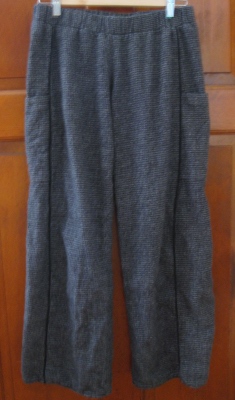 (I know: low light, rumple-riffic, but hey, people — this is flannel, and I’m a sewist, not a photographer!)
(I know: low light, rumple-riffic, but hey, people — this is flannel, and I’m a sewist, not a photographer!)
I made some changes to the pattern. The legs are drafted to be quite long, and my own are quite short, so I lopped off 3.5 inches. (If you do this, make sure that you remember to shorten the side panel, too!) I cut a size 8; at my correct inseam length, only 2 packages of commercial piping were needed. And I removed the fake fly, because what? No need for a fly here, faux or otherwise.
(Flash this time; an improvement? Hard to say!)
I left the waist band placement as drafted, even though I was pretty sure that it was going to fall lower on my hips than I prefer. (Let’s just say that I’m not really trend-forward, opn any front!) That turned out to be true; these pants ride at the point where my usual PJ pants fall once I’ve rolled them down.
It turns out I don’t like this in the finished garment; that makes no sense at all, but there you are. The front is lower than the back, but not as angled as this image makes it seem. That makes for a nice fit. The drop is not as much as it appears to be in my photo — the tilt of the hanger is exaggerating the tip toward the front.
The piping really makes the pants. I used jumbo piping, because I wanted it to stand out without getting lost in all that soft flannel. To make sure that it went in evenly, I did something I rarely do: I not only pinned it in place, but then basted it with a large zigzag stitch to ensure that it didn’t slip when assembling the layers. This took only a few minutes extra, and was well worth the expenditure of time.
The legs are super-wide. That’s a nice feature, and this width is probably perfect on a longer-limbed woman. I’ll take them in for my next pair, though, as this is too much fabric on my smallish frame. You can see in the photos that the proportions aren’t particularly pleasing to the eye when the legs are this short — but the width does make for very cozy wearing!
I added pockets to the side panels. I hemmed the top of each pocket by attaching grosgrain ribbon to the right side of the fabric, then adding a row of zigzag stitches to finish the enclosed raw edges. Then I folded the pocket hem over and stitched the grosgrain along the opposite edge to make the pocket hem.
Then I sewed the bottom of the pocket, right side to right side, onto the leg panel, and folded it up so that the pocket sides aligned with the seams of each side panel. The pocket is automatically finished when the side seams are sewn.
The grosgrain acts as a kind of gentle interfacing to better define the pocket edge (so it doesn’t cling to the flannel) and to support the upper pocket so that it doesn’t sag. The edges of the pocket will wear better, too, because of this small bit of reinforcement.
In the end, I decided against the bow. Although I love it, it would just be a pain in every day life, especially since I wear my flannels with long overshirts. And I cut another corner: The instructions call for encasing the elastic in a fully-enclosed waistband. I just folded the waistband over, matched the edges, and stitched it to the pants.
A diaper pin makes the perfect threader for wide elastic!
Tasia’s method is better because it gives a nice, clean, look to the inside of the pants. Also, my method results in some seam allowance bulk that “poufs” the pants out slightly just below the waistband. I don’t care about this, personally, so I went for the quiick-and-dirty solution, but almost everyone who makes these pants will probably feel differently . . .
Sewaholic patterns have consistently clear directions, are drafted beautifully, and are stunningly beautifully done . The level of professionalism, where professionalism is defined as “precision, care, and skill” is awe-inspiring. Few companies (and none of the Big Four) come close to this kind of quality.
Speaking of which, I was floored to see that Tasia had included a pattern piece for the necessary bias strips for those who want to make their own piping. Whoo-hoo! I can’t stand drawing long lines on fabric, nor rotary cutters, so this is real incentive to make my own piping sometime in the future.
Oh, and that bow? There’s a pattern piece for that, too. None of this “go buy wide ribbon” stuff. Your contrast bow can match your piping perfectly, if you’re so inclined.
Feet I used for this project:
Seam allowance foot with IDT, for non-piped seams (posed for photo purposes only — the pin should be parallel to the foot, not cock-eyed like this, and, anyway, they get removed just before the foot would strike them);
cording foot for installing the piping;
edge stitch foot, for “stitching in the ditch” where the waistband attaches to the pants:
and standard multi-purpose zig-zag foot, which I forgot to photograph.
For the crotch seam, I used a triple stitch, which adds strength and some elasticity to the area where seams show the greatest stress:

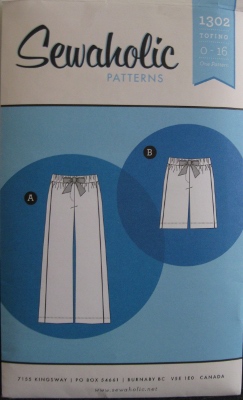
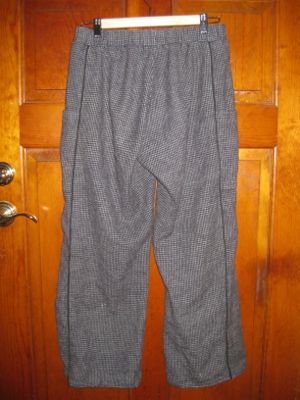
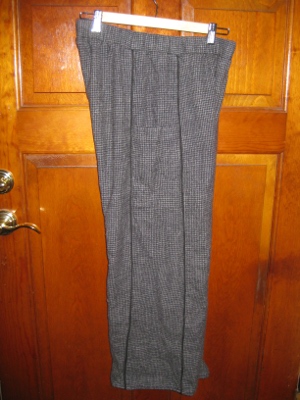
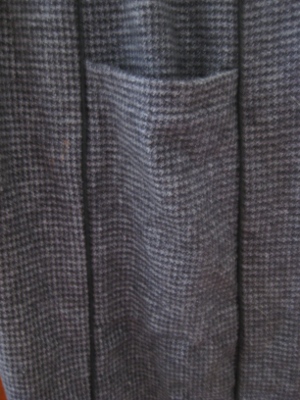
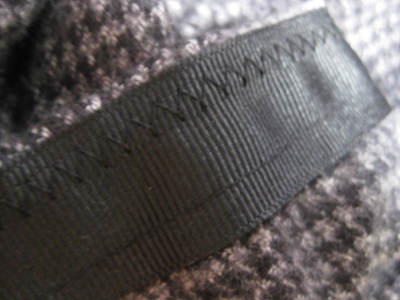
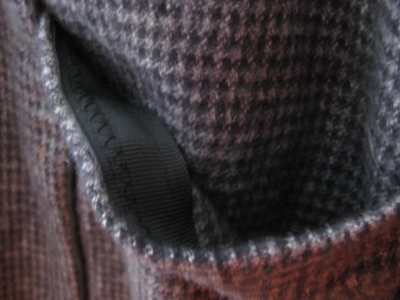

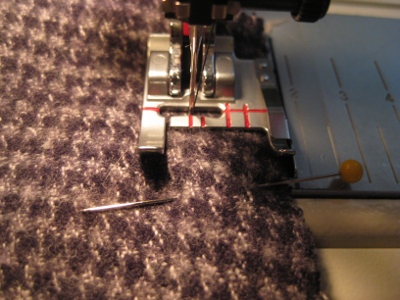
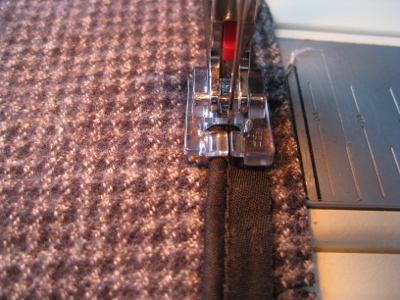
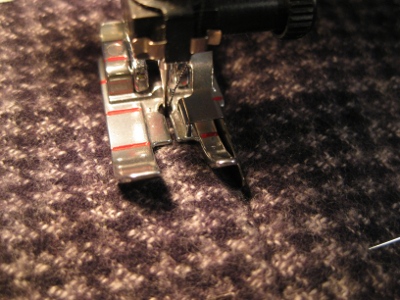
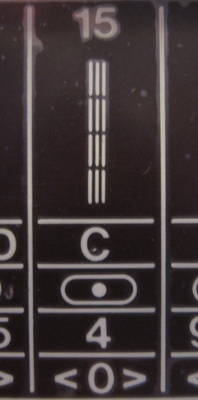
Noile! You’re back!! Yay!!!
Hey, Kyle! Thanks for the welcome!
Oh, Noile, it’s so great to see you sewing again! These pants look great! I have avoided the pants from this company because I am not a pear shape and I’m a small size, to boot. I wonder if they would even accommodate a slim 34″ hip.
Thanks, Shams! You are really in the tiny zone now — finished measurements for the Tofino pants in size zero (!) are 26 inch waistband, 43 inch hips. That’s a lot of ease in the hip for someone your size — though they are essentially jammies, so your mileage may vary. I chose my size by the waist — loose waist, since I wanted lots of room — but apparently didn’t notice that gave me more than a foot of ease in the hip. (Hmmm . . . maybe I’m a little out of practice?)
Sewaholic uses its own size chart, which is a smart move, considering that they have a specific target demographic. Gotta love having the finished garment measurements on the envelope, too!